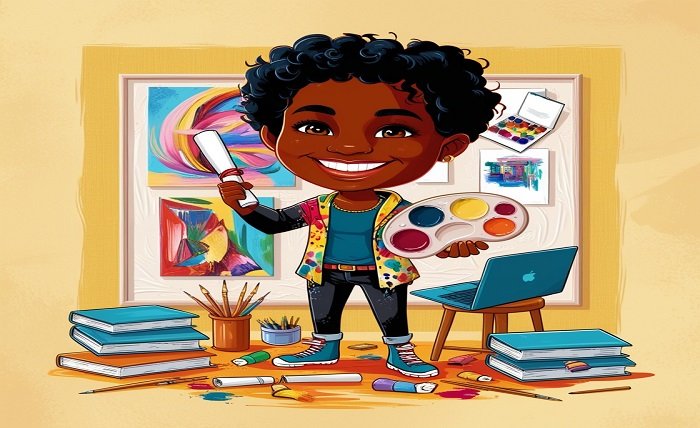Overview
Through art, people from different generations and cultures may connect and transcend borders. In addition to developing one’s artistic abilities, an art education degree gives people the means to uplift and instruct others. This article examines the value of earning a degree in art education, the different career paths that are accessible, and the plethora of opportunities that graduates can pursue.
The Development of Art Education
Art education has a long and diverse history that dates back to ancient societies. Apprentice-based systems, in which young artists would study their profession under the guidance of a master, are examples of early types of art education degree. The establishment of art academies throughout the Renaissance formalized art education and raised its social standing. The field of art education has expanded over time to include many different disciplines and approaches.
Various Degree Programs in Art Education
There are several types of art education degree, ranging from associate’s to doctoral. Typically, an associate degree includes core courses in education and the arts, serving as a springboard for entry-level jobs or additional education. In order to prepare students to teach art at different levels, a bachelor’s degree in art education typically combines studio practice, art history, and educational philosophy. Advanced teaching methods and specific fields like digital media or art therapy are frequently the focus of master’s programs.
Essential Courses for a Degree in Art Education
A typical art education degree combines education theory, art history, and studio practice. Students can hone their abilities in a variety of media, including painting, sculpting, and digital art, by enrolling in studio practice courses. Students who take art history classes gain a thorough awareness of the historical and cultural backgrounds of art, which improves their capacity to both teach and appreciate it.
Technology’s Place in Art Education
Technology has changed how art is made and taught. Since they enable students to try out new methods and media, digital tools like graphic design software, 3D printing, and online portfolios have become essential to art education degree. Students may now study from classmates and teachers worldwide thanks to virtual classrooms and online learning platforms, which have greatly increased access to art education.
Careers for Graduates in Art Education
There are numerous employment choices available to graduates with a art education degree. Although it’s typical to teach art in schools from elementary to high school, there are plenty of additional options. Art educators can create educational programs and provide tours in galleries and museums. Art educators are frequently sought after by community centers and nonprofits to conduct outreach initiatives and seminars.
The Value of Art Teachers in Classrooms
Students’ creativity and critical thinking are greatly enhanced by art education degree. Art instructors give pupils a much-needed platform to express themselves and develop their ideas in an increasingly homogenized educational system. Participating in the arts has been linked to increased social skills, self-esteem, and academic success, according to research.
Art Education in the Community
There is more to art education degree than just the classroom. Community-based initiatives promote a feeling of community and provide worthwhile educational opportunities. These initiatives, which make art accessible to a wide range of people, frequently center on social justice, community involvement, and cultural preservation. We’ll talk about effective community art projects and their advantages, like fostering a sense of community, empowering people via artistic expression, and celebrating cultural heritage.
The Advantages of a Degree in Art Education
A degree in art teaching provides more than just artistic abilities. It fosters the growth of emotional intelligence, cultural sensitivity, and critical thinking. art education degree the skills necessary to effectively convey difficult concepts, accommodate various learning preferences, and establish welcoming environments. Graduates of art schools are adaptable and well-rounded because of these abilities, which are useful in any line of work.
Art Education in a Worldwide Setting
Cultural and regional differences exist in art education degree. While some nations embrace modern methods, others place a higher priority on traditional creative forms. Collaborations and international exchange programs have enhanced art education by enabling teachers and students to gain knowledge from a variety of viewpoints. International viewpoints on art education and the impact of international exchange initiatives are examined in this section.
Summary
A rewarding career that blends creativity and the love of teaching can be attained with an art education degree. It gives people the ability to uplift others and add to society’s cultural tapestry. The significance of fostering and assisting art instructors is becoming increasingly clear as the sector develops. Art education is essential for promoting creativity, critical thinking, and cultural understanding in classrooms, community programs, and international projects.
FAQ
With a degree in art education, what are your options?
art education degree can work in community arts programs, museums and galleries, teaching, and other fields. The acquired abilities are also suitable for positions in the creative industry.
What is the duration required to obtain a degree in art education?
The degree level determines this. It normally takes two years to earn an associate’s degree, four years to earn a bachelor’s degree, and two to six years to earn a master’s or doctoral degree.
Which abilities are crucial for art educators?
Creativity, communication, patience, organization, and a thorough comprehension of both creative methods and educational theories are essential abilities.
Does art education need the use of technology?
Of course. In order to improve teaching and creative practices, digital tools and platforms have become essential to modern art education degree.
Are degrees in art education offered online?
Indeed, a lot of universities provide hybrid or online programs, giving students who are unable to attend classes on campus flexibility. Learn more about: jean of fashion crossword clue
What difficulties do art educators encounter?
Funding shortages, curriculum restrictions, and the requirement to promote the benefits of art education degree in an educational system that prioritizes standardized testing are among the difficulties.

